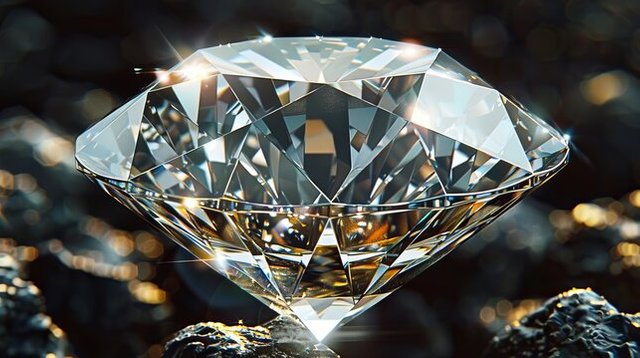Diamond

Diamonds are precious gemstones made of carbon atoms arranged in a crystal lattice structure. Known for their brilliance, durability, and rarity, diamonds have captivated human fascination for centuries and hold significant cultural, economic, and scientific value.
Formation and Characteristics
Diamonds are formed deep within the Earth’s mantle, at depths of about 140 to 190 kilometers (90 to 120 miles), under extreme pressure and high temperatures of around 1,000 to 1,300 degrees Celsius (1,832 to 2,372 degrees Fahrenheit). They are brought closer to the surface through volcanic eruptions in magma, which solidifies into kimberlite or lamproite pipes. This geological process takes millions to billions of years.
The key characteristics that define diamonds are:
- Hardness: Diamonds are the hardest natural substance on Earth, rated 10 on the Mohs hardness scale. This makes them resistant to scratches, which is why they are popular in jewelry and industrial applications.
- Brilliance and Fire: Diamonds have a high refractive index (2.42), allowing them to bend light effectively. When cut properly, they can display exceptional brilliance and fire (the dispersion of light into its spectral colors), giving diamonds their signature sparkle.
- Clarity: The clarity of a diamond is determined by the presence of internal inclusions or external blemishes. The fewer these imperfections, the higher the clarity grade and value.
- Color: While pure diamonds are colorless, most natural diamonds have slight tints of yellow or brown due to trace elements. There are also rare "fancy" diamonds with vivid colors like blue, pink, green, or red, which are highly valued.
- Carat Weight: Carat is a unit of measurement used to determine a diamond’s weight, with one carat equivalent to 0.2 grams. Larger diamonds are rarer and thus more valuable.
The 4 Cs of Diamonds
When assessing the quality of diamonds, experts consider the "Four Cs": Cut, Color, Clarity, and Carat weight.
Cut: Refers to how well the diamond is shaped and faceted to maximize its brilliance.
Color: Graded from D (colorless) to Z (light yellow or brown), with colorless diamonds being the most valuable.
Clarity: Measures the absence of internal flaws (inclusions) and surface defects (blemishes).
Carat: The weight of the diamond, where larger diamonds are generally more valuable.
Natural vs. Lab-Grown Diamonds
With advances in technology, diamonds can now be created in laboratories, using methods like High Pressure, High Temperature (HPHT) and Chemical Vapor Deposition (CVD). Lab-grown diamonds have the same physical, chemical, and optical properties as natural diamonds but are more affordable and ethically sourced, making them increasingly popular among consumers.
Uses of Diamonds
Diamonds are prized not only for their beauty in jewelry but also for their practical uses:
- Jewelry: Diamonds are commonly used in engagement rings, necklaces, earrings, and other fine jewelry pieces due to their brilliance and enduring appeal.
- Industrial Applications: Due to their extreme hardness, diamonds are used in cutting, grinding, and drilling tools. Diamond-tipped blades and drills can cut through hard materials like concrete and stone.
- Scientific Research: Diamonds are used in scientific equipment such as high-precision optics, heat sinks, and semiconductor devices because they have excellent thermal conductivity and are transparent to a wide range of light wavelengths.
Symbolism and Cultural Significance
Diamonds are often associated with love, purity, and eternal commitment, making them a popular choice for engagement rings. The famous slogan "A Diamond is Forever," coined by De Beers in 1947, helped establish diamonds as symbols of enduring love. They are also regarded as status symbols, signifying wealth and prestige.
Famous Diamonds
Some of the world’s most famous diamonds include:
The Cullinan Diamond: The largest gem-quality diamond ever discovered, weighing over 3,100 carats before it was cut.
The Hope Diamond: A 45.52-carat blue diamond known for its striking color and legendary curse.
The Koh-i-Noor: An ancient diamond with a rich history, now part of the British Crown Jewels.
Ethical and Environmental Considerations
The diamond industry has faced criticism for its association with conflict diamonds, also known as blood diamonds, which are mined in war zones and sold to finance armed conflict. Efforts like the Kimberley Process Certification Scheme have been implemented to curb the trade of conflict diamonds and promote ethical sourcing.
Additionally, diamond mining can have significant environmental impacts, including habitat destruction, soil erosion, and water pollution. The rise of lab-grown diamonds offers a more sustainable and ethical alternative to traditional mining.
Conclusion
Diamonds continue to hold a unique place in the world, combining natural wonder with cultural significance. Whether natural or lab-grown, they remain a symbol of luxury, commitment, and enduring beauty. With growing awareness of ethical sourcing and environmental sustainability, the diamond industry is evolving to meet modern standards, ensuring that the allure of diamonds can be enjoyed responsibly for generations to come.